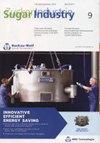Monitoring juice hold-up in a cane diffuser bed using electrical conductivity – evaluation on a plant scale
IF 0.2
4区 农林科学
Q4 FOOD SCIENCE & TECHNOLOGY
引用次数: 1
Abstract
The extraction of sucrose in a sugarcane diffuser depends on the percolation rate of juice through the cane bed. High percolation rates promote mass transfer and increase the wetness of the cane bed (i.e. liquid hold-up within the bed) thereby improving sucrose extraction. However, increasing the rate of juice applied to the surface of the cane bed above the maximum percolation rate results in flooding, causing uncontrolled mixing of juice, destruction of the dry substance content profile and reduced extraction. Flooding in the diffuser can be avoided by installing feedback control of adjustable sprays that alter the application area of juice onto the bed surface and automatically keeping the percolation rate optimised. Electrical conductivity of the cane bed, measured between the bed surface and the bottom screen of the diffuser, has been investigated as a possible online indicator of juice hold-up within the cane bed to provide the necessary measurement for implementing feedback control that can optimise percolation rates. Full scale tests were conducted on the Tongaat Hulett cane diffuser at the Maidstone factory. Reproducibility tests were done to confirm that there is a relationship between conductance and liquid hold-up.用电导率监测甘蔗扩散床中的果汁潴留。在工厂规模上进行评价
甘蔗扩散器中蔗糖的提取取决于甘蔗床中果汁的渗透速率。高渗透率促进了传质,增加了甘蔗床的湿度(即床内的液体保持率),从而改善了蔗糖的提取。然而,在甘蔗床表面的最大渗透速率以上增加果汁的速率会导致水淹,导致果汁混合不受控制,破坏干物质含量剖面,减少提取。通过安装可调节喷雾的反馈控制,可以避免扩散器中的溢水,该喷雾可以改变床表面上果汁的应用区域,并自动保持最佳的渗透速率。甘蔗床的电导率,在床表面和扩散器的底部屏幕之间测量,已经被研究作为甘蔗床内果汁保持的可能的在线指标,为实施反馈控制提供必要的测量,可以优化渗透速率。在梅德斯通工厂对汤加特休利特甘蔗扩散器进行了全尺寸试验。进行了重复性测试,以确认电导和液体保持率之间存在关系。
本文章由计算机程序翻译,如有差异,请以英文原文为准。
求助全文
约1分钟内获得全文
求助全文
来源期刊

Sugar Industry-Zuckerindustrie
工程技术-食品科技
CiteScore
0.50
自引率
50.00%
发文量
22
审稿时长
18-36 weeks
期刊介绍:
Sugar Industry / Zuckerindustrie accepts original papers (research reports), review articles, and short communications on all the aspects implied by the journals title and subtitle.
 求助内容:
求助内容: 应助结果提醒方式:
应助结果提醒方式:


